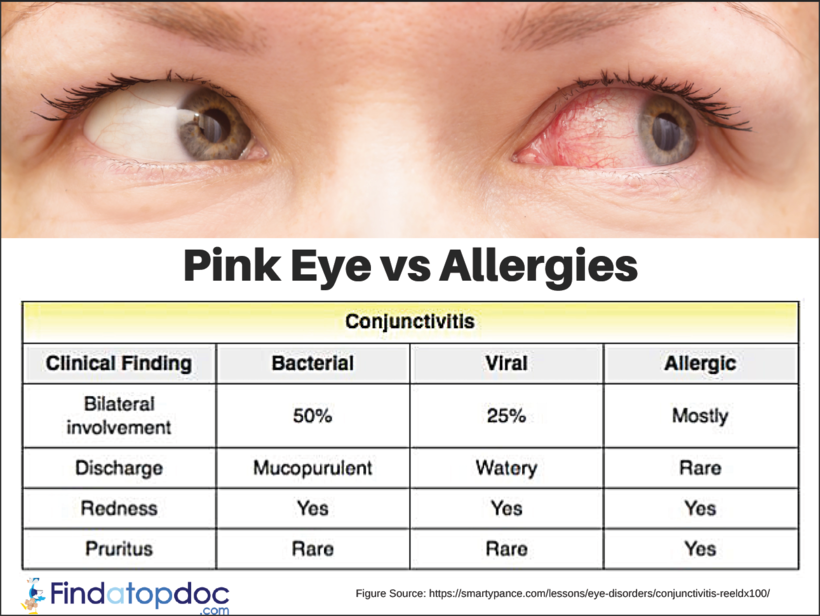
Your eyes are incredibly sensitive to irritants and microbes. While red eyes can come from not getting enough sleep or just not blinking enough, they can also be a sign of infections or disorders. Pink eyeis one of the most common ailments to your eyes, but many people have trouble distinguishing between pink eye and regular seasonal allergies. While the symptoms can overlap, they are two distinct health issues. Getting the right treatment requires the right diagnosis. Let’s take a look at pink eye and seasonal allergies and what sets the two apart.
Why Your Eyes Turn Red
The whites of your eyes are known as the sclera. The sclera is actually home to thousands of blood vessels that are normally constricted, making them nearly invisible. This maintains the white color that you normally see.
However, when you have something in your eye or suffer something that causes inflammation in your eyes, the blood vessels dilate, becoming more apparent. This creates the redness that is characteristic to many ocular ailments, including pink eye, dry eyes, allergies, and more.
What is Pink Eye?
Pink eye, also known as conjunctivitis, refers to a contagious infection in the conjunctiva of your eye. This is the thin mucus layer that lines the outsides of the white area of your eye. Pink eye is one of the most common eye ailments.
Each year, doctors report over 3 million cases of pink eye in the United States. While it can affect anyone of any age, it is most common in children and their parents and teachers as schools often make the perfect environment for contamination and spreading the disease.
Causes of Pink Eye
When most doctors say “pink eye,” they are referring to its viral form. Viral conjunctivitis is the most common form of pink eye and is most commonly caused by adenovirus, a virus normally responsible for causing upper respiratory infections and sore throats. In rarer instances, viral pink eye may be caused by:
- Herpes simplex virus
- Picornavirus
- Varicella zoster virus
- Poxvirus
Next to viruses, bacteria are the next leading cause of pink eye. Staphylococcus and Streptococcus are the bacteria most often implicated in conjunctivitis. These bacteria are usually associated with food poisoning and strep throat, respectively.In rare instances, bacterial pink eye has been caused by the bacteria responsible for chlamydia and gonorrhea. In these cases, the mother may be a carrier of the bacteria and pass it down to her newborn during birth, but most hospitals are required to put drops of ointment in the infant’s eyes to prevent this form of pink eye.
What are Seasonal Allergies?
Switching gears, let’s look at seasonal allergies. About 8 percent of adults in America suffer from seasonal allergies, which is also known as seasonal allergic rhinitis or hay fever. Despite the name, seasonal allergies can happen all year round, though they tend to be less common in the winter.
Depending on the allergen that triggers symptoms, you may experience allergies during more than one season. Mold, pet dander, dust, and other indoor allergens can also trigger an allergic reaction.
What Causes Seasonal Allergies?
Allergic rhinitis happens when your immune system thinks that a normally harmless substance is actually dangerous. The body responds by releasing histamines and other chemicals into your bloodstream as an attempt to defend your system. These histamines and chemicals are what produce the symptoms of seasonal allergies.
Think of histamines as your bodyguards. They are created in your mast cells and help your body get rid of things that may bother you or cause you harm. Despite what they do to you, they are ultimately beneficial to your health and natural defenses.
They begin the process of removing allergens from your body or off the surface of your skin through any means necessary. This unfortunately means sneezing, coughing, crying, or itching.
When histamines are first released, they boost blood flow to the area where the allergens have taken affect. This triggers the process of inflammation, which signals your immune system to send other chemicals to begin repairs and healing.The substances that trigger your allergies vary from person to person and season to season.
- Spring: Trees, particularly birch, cedar, poplar, and horse chestnut
- Summer: Grasses, like ryegrass, and weeds
- Fall: Pollen from ragweed, nettles, and mugwort
- Winter: Mainly indoor allergens, including mold, dust mites, cockroaches, and pet dander
Symptoms can be a big help in differentiating between pink eye and allergic rhinitis. The symptoms for pink eye generally center entirely around the eyes. The symptoms for allergies can center more around your ears, nose, and throat and general congestion. The best way to know for sure is to get a professional diagnosis from your doctor.


